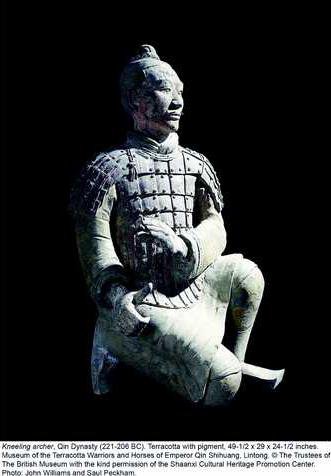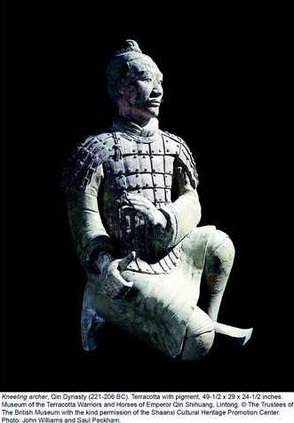‘The First Emperor: China’s Terracotta Army’
When: 10 a.m. to 5 p.m. Tuesdays, Wednesdays, Fridays and Saturdays, 10 a.m. to 8 p.m. Thursdays, noon to 5 p.m. Sundays through April 19. Closed today. Special hours for Go All Night!, 9 a.m. to midnight Friday.
Where: High Museum of Art, 1280 Peachtree St. NE, Atlanta
How much: $18 adults, $15 seniors age 65 and older, $15 students $11 children ages 6 to 17, free for children age 5 and younger
More info: 404-733-4400
ATLANTA — They’ve been standing guard at the emperor’s tomb for thousands of years, but now the soldiers of the terracotta army are taking a break to spend the holidays at the High Museum of Art.
"The First Emperor: China’s Terracotta Army," on view at the High through April 19, gives visitors a close-up look at nine towering members of the army, created more than 2,000 years ago, and other items excavated from the underground palace surrounding Emperor Qin Shihuangdi’s tomb.
The exhibit also shows how the well-preserved clay figures were created, and gives museum-goers a look into the life of Qin Shihuangdi, who reigned from 221 to 210 B.C.
"He basically conquered the other six states and in 221 B.C. he united China. And in uniting China, he basically changed the way the whole country had to be organized," said Hiromi Kinoshita, the consulting curator for the exhibit.
"Each state had their own way of writing. They had, probably, their own dialects of speaking, weights and measures. Everything had to be standardized, and that’s what he did."
Kinoshita said things like money and script, standardized by the first emperor, lasted until the 20th century, to the last Chinese dynasty, which gives the emperor credit for China’s long cultural history.
Shihuangdi also is credited with orchestrating the construction of the Great Wall of China.
"The First Emperor" illustrates the emperor’s achievements, with examples of weapons, coins, weights and measures and a restraining iron that shows how he used forced labor to build the tomb complex.
Figures from the tomb — including the army, chariots, acrobats and a "strong man," which were included to entertain the emperor — show how extensively he planned his "afterlife" and that he planned to continue to rule even in death.
The emperor began construction of his tomb before his reign, when he was King of Qin, one of China’s "warring states." He was 13 at the time.
Then, at age 38, he became emperor, and construction was stepped up to create the extensive underground palace.
The army, in three large pits, stands far from the palace and is estimated to be 7,000 strong. Since the army was discovered in 1974, 1,000 of the figures have been excavated. "The First Emperor" is the largest exhibit of terracotta soldiers ever to travel to the United States.
"The figures are very large in size," Kinoshita said. "They actually stand 6 foot to 6 foot 5 inches tall, and we think that they are probably representing a superior, a really perfected, fighting force."
The nine soldiers and six civilian entertainers included in the exhibit each bear individual characteristics and facial expressions.
Kinoshita said each body part was separately molded, then the parts were assembled, making it possible to produce 7,000 figures in a short period of time.
The sculptures display sophisticated artistic talent, but aren’t necessarily representative of other art in China during that time period, Kinoshita said.
"What’s so amazing is, if you look at other tombs of the same period — granted, they’re not of an emperor, but they’re of high-ranking people — it’s quite primitive," she said. "A lot of Chinese archaeologists still are puzzled how they were able to create these realistic sculptures because it seemed to have suddenly appeared out of nowhere, and just this 11-year period happened during the first emperor’s reign, and then it sort of disappeared.
"So it is, in terms of sculpture, pretty amazing."

